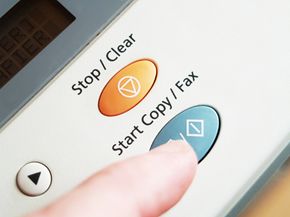Receiving a Fax
The bits for the scanned document travel through the phone line and arrive at a receiving fax machine. The bits are decoded, uncompressed and reassembled into the scanned lines of the original document. There are five common ways to print the fax, depending on the type of machine that receives it:
Thermal paper -- When fax machines started infiltrating offices en mass in the 1980s, most of them used thermal paper. The paper is coated with chemicals that react to heat by turning black. Thermal paper has several big advantages:
Advertisement
- It's very inexpensive to build a thermal printer.
- Thermal printers have no moving parts except for the paper-feed mechanism.
- There are no expendables like ink or ribbons because the paper contains the ink.
- Thermal printers are nearly indestructible.
- The only disadvantage is that the paper discolors over time, and it turns completely black if you leave it in a hot car.
Thermal film -- Thermal film uses a page-width ribbon that contains ink that melts onto paper when heated. This is more complicated mechanically than thermal paper but less complicated than an inkjet.
Inkjet -- This technique uses the same mechanism as an inkjet printer.
Laser printer -- This technique uses the same mechanism as a laser printer.
Computer printer -- The fax is actually received by a fax modem (a modem that understands the Group 3 data standards), stored on the computer's hard disk as a graphics file and then sent to the computer's usual printer.
Find out how to use a fax machine on the next page.
